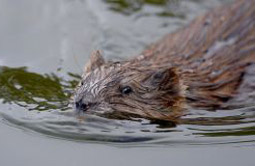Muskrat
The muskrat is a rodent that belongs to the family of the vole (Arvicolidae). The muskrat is to be found in the subarctic and moderate zone of North America. Humans brought the muskrat to Eastern Europe from where it spread throughout Northern Eurasia. Its fur is reddish-brown with dark kempy wool that is very dense, so that the tiny ears can hardly be seen in the dense fur. Its body is sturdy, with short legs and large feet. Muskrats reach a head to tail length of 30 to 36 cm and a tail length of 20 to 25 cm and weigh between 800 and 1,600 g. In the wild, their lifespan amounts to 3 years on average. In captivity, they can reach up to 10 years of age.
Muskrats live near water and are excellently adapted to aquatic life. Their dense fur can store air, thus helping them to swim and to keep warm. Muskrats are outstanding swimmers and divers. They can remain under water for up to 15 minutes at a time. They have webs on their hind legs and use their scaly and vertically flattened tails to swim. Muskrats are most comfortable in swamplands where water levels are fairly stable which ensures that the spacious caves to live in are rarely or never flooded. Unfortunately, precisely this digging leads to conflicts with human beings, because the digging erodes shore constructions and makes entire shore sections slide. Muskrats are therefore often considered to be vermin with regard to road and water construction. Often, muskrats do not even dig but build „castles“ by layering reed and canes and thus forming large piles that often also serve waterfowl as nesting places. The muskrat is primarily active between noon and dusk and spends the rest of the time in its den. Muskrats primarily feed on plants and roots that they find in the water. They also feed on small animals, clams, crabs or insects.
Muskrats live in large families and in clearly defined territories. They communicate with other muskrats by leaving odor marks and making noises. Their mating season depends on the climate. In the North, the mating season is usually from March to August; in the Southern regions, muskrats can have offspring throughout the year. Females have 6 young on average, following a gestation period of 30 days. Although they are still suckled, the young attempt excursions outside of the den after only a few days time. At 10 days of age, they are already able to swim. For as long as they have sufficient food and space, the young will remain in the group after having been weaned. If the number of young, however, exceeds the carrying capacity of the territory, the mother animal will chase away the adolescent animals the following spring.


